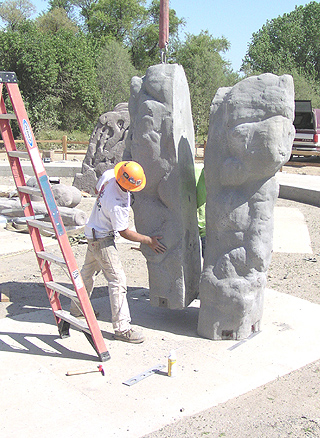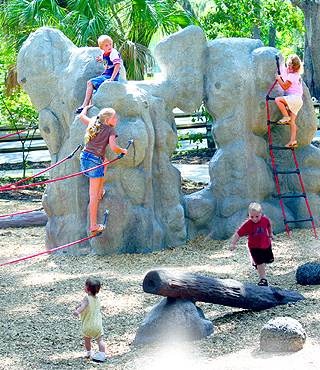
Surveys
DJC.COM
April 5, 2007
Designing playgrounds for the next generation
BOLDR

Images courtesy of BOLDR BOLDR playgrounds can be built into any configuration, thanks to 3-D design software. |
Nearly four decades ago I started my career building kids’ playgrounds. Actually what I thought I was doing was making play sculptures. I even had a one-man show at the San Francisco DeYoung Museum.
That was when I lived in “the city” and was doing “build your own playgrounds” with dozens of schools and thousands of volunteers. Being an artist in San Francisco in the late 1960s was a whole lot of fun.
But fun does not necessarily pay the bills so I approached BigToys, located at the time in Tacoma, to use its log system to construct our designs. That turned out to be a most fortunate partnership, as we installed hundreds of Schoolyard BigToys across America.
But changes in one’s directions and business are often driven by new developments in other fields. This was true in my case when I saw the advent of thin-wall tubing, rotocast plastic and powdercoating as an opportunity to develop a “high-tech” version of my play structure concept. The first version of the new post-and-deck play structure idea was called PlayBoosters and was later followed by Kid Builders. Those two ranges continue to be vigorous sellers and are now cloned by virtually every other play equipment manufacturer.
It turns out that one can be too successful, in this case it meant that most other types of play equipment have been forced out of the market. For the past 15 years playgrounds have begun to look more and more alike. The law of unintended consequences strikes again.
Changing play habits

BOLDR playgrounds are made with light-weight concrete elements. |
What I’ve been observing lately is that kids, especially those 10 years and older, play differently than they did decades ago. They are into skateboarding, rock climbing, mountain biking and other “individual” sports. I had also learned that new materials might lead to truly innovative climbers. I was particularly interested in concrete because it is durable, cheap and can be environmentally sound. It also can be any shape imaginable, so it allows for unlimited creativity.
Putting these two elements together, we launched a sculptural precast concrete climbing wall system for parks called TrainR by BOLDR. This was an instant hit with parks and kids. We followed this product with a whole range of naturalistic rock climbing sculptures. Again the industry copied us and most companies now have a “rock” of some sort. Unfortunately these are all made of glass-reinforced concrete, which doesn’t give a nice climbing surface.
About three years ago we thought we’d try connecting some of our rocks with ropes. At about the same time a military base called and wanted a big rock climbing garden — space and budget completely open. We put the two together and designed the first Rocks and Ropes Adventure Course. They loved it.
Since then we’ve shown the idea to dozens of clients and virtually everyone has asked “When can we get one?” Astounding. These seem to fit in well with the larger projects, ones that would have a skatepark or a spray park. The surprise is that the Adventure Course appeals to both boys and girls. We even see lots of adults using them.
What we learned about materials being a source of innovation has proven to be true again. In this case we found a “rope” that has a steel core that is very vandal resistant. We also developed an advanced concrete mix that has no rebar or rocks in it. Since we’ve got a patent pending, I can tell you its “secret” ingredients are structural fiber and a polymer that reduces weight by 40 percent while retaining the mix’s strength. In addition, we use sophisticated 3-D graphics to design the sculptures. The computer files are sent to a huge router that cuts out molds into which the concrete is poured. We are literally printing playgrounds to any shape you can imagine.
Being green

The Rocks and Ropes playgrounds appeal to kids of all ages. |
What is really cool, and very important to us, is being as green as we can. Our plant is situated on top of an old placer mine, which supplies the aggregate that makes up more than 80 percent (by weight) of our product. That means we use an industrial waste (tailings) and a minimal amount of energy to create and bring raw material to the plant. There is no new environmental damage. Also, since our product weighs less than regular concrete it takes less energy to ship.
Our product is 100 percent recyclable locally. While many products claim to be recyclable, the process by which this is accomplished is often energy intensive, generally shipping the materials thousands of miles. Nearly every community has a concrete recycling capacity.
While recycling is great, sometimes it is better to not create the problem in the first place. In our society we throw billions of tons of “stuff” away every year. The Rocks and Ropes system is designed to last indefinitely. The product can long endure extreme weather, vandalism and even changing ASTM standards. It will still be in use decades after other play systems have been “recycled.”
Many of today’s playgrounds use plastics and plastic coatings, which have serious environmental problems. We have none of that. We do not produce a printed catalog; you can only access our information electronically. This saves a whole lot of trees and energy shipping stuff around.
We make and use bio-diesel in our vehicles, and the plant is heated with reclaimed oil. Our goal is to become “carbon neutral” as quickly as possible. With that in mind, a wind generator for the plant is in the works and solar energy will soon be used to power our offices.
The future
We are developing four entirely new playground systems. We think our next ideas are going to be even bigger than what we’ve done so far. Development is slower than we’d like because we have to pioneer one concept into profitability before we can launch the next one. That gets discouraging, but on the other hand we’ve introduced lots of new ideas and along the way helped to transform playgrounds everywhere.
Anyway, we’re sure having fun. Maybe not as much fun as a hippy artist in the ‘60s San Francisco, but quite as much as I need, thank you.
Jay Beckwith is the founder of BOLDR, a designer and manufacturer of climbing structures based in California.
Other Stories:
- Celebrate National Landscape Architecture Month
- Add value to your team with a landscape architect
- Making freeways more than just pavement
- UW team transforms garbage into gardens
- Park design gets a boost from street skaters
- How landscaping is greening up Seattle
Copyright ©2009 Seattle Daily Journal and DJC.COM.
Comments? Questions? Contact us.